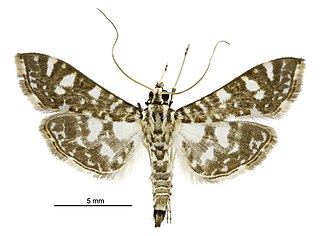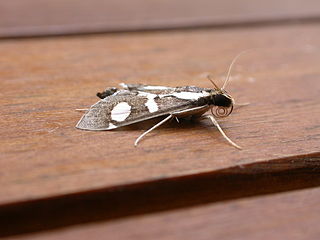
Ailuropoda microta is the earliest known ancestor of the giant panda. It measured 1 m (3 ft) in length; the modern giant panda grows to a size in excess of 1.5 m (5 ft). Wear patterns on its teeth suggest it lived on a diet of bamboo, the primary food of the giant panda. The first discovered skull of the animal in a south China limestone cave is estimated to be 2 million years old. The skull found is about half the size of a modern-day giant panda, but is anatomically very similar. This research suggests that the giant panda has evolved for more than 3 million years as a completely separate lineage from that of other bears.

Glyphodes is a genus of moths of the family Crambidae described by Achille Guenée in 1854.

Diaphania indica, the cucumber moth or cotton caterpillar, is a widespread but mainly Old World moth species. It belongs to the grass moth family, and therein to the large subfamily Spilomelinae. This moth occurs in many tropical and subtropical regions outside the Americas, though it is native to southern Asia; it is occasionally a significant pest of cucurbits and some other plants.
Glyphodes cyanomichla, the blue glyphodes moth, is a moth of the family Crambidae. It is endemic to the Hawaiian islands of Kauai, Oahu, Molokai and Hawaii.

Glyphodes bivitralis is a moth of the family Crambidae described by Achille Guenée in 1854. It is native to south-east Asia, including Hong Kong, India, Japan, Taiwan and Thailand. It is also found in Queensland, Hawaii and Maldives.

Glyphodes onychinalis is a moth of the family Crambidae. It is native to the Afro-Asian Region, including India, Sri Lanka, Hong Kong, Thailand, Indonesia, Japan, Australia and New Zealand, and has been recorded in California since 2000.

Glyphodes negatalis, the karanj defoliator, is a moth of the family Crambidae. The species was first described by Francis Walker in 1859. It has a wide range in the tropics, including South Africa, The Gambia, Mali, India, Sri Lanka, Hong Kong, Japan, and eastern Australia.

Glyphodes bicolor is a species of moth of the family Crambidae described by William John Swainson in 1821. It is widely distributed in the Old World tropics, including South Africa, China, Thailand, India, New Guinea and Australia.

Agrioglypta itysalis is a moth of the family Crambidae. It is found in Asia, including India and Borneo.

Glyphodes boseae is a moth of the family Crambidae. It was described by Max Saalmüller in 1880 and it is found in Madagascar.

Glyphodes multilinealis, the fig-tiger-moth, is a species of moth of the family Crambidae described by George Hamilton Kenrick in 1907. It is found in Papua New Guinea, Fiji, Niue, the Cook Islands, the Society Islands, in Australia and Japan.

Glyphodes perspicualis is a species of moth of the family Crambidae. It was described by George Hamilton Kenrick in 1907 and it is found in Papua New Guinea.

Glyphodes paucilinealis is a species of moth of the family Crambidae. It was described by George Hamilton Kenrick in 1907 and is found in Papua New Guinea.

Glyphodes cyanomichla is a moth of the family Crambidae described by Frederic Moore in 1888. It is found in the Bengal region and in Taiwan.

Glyphodes pulverulentalis is a moth of the family Crambidae. It was first described by George Hampson in 1896.

Glyphodes pyloalis, the lesser mulberry snout moth, lesser mulberry pyralid or beautiful glyphodes moth, is a moth in the family Crambidae. It was described by Francis Walker in 1859. It is found in Iran, China, Japan, India, Indonesia (Sumatra), Sri Lanka, Taiwan, the Democratic Republic of the Congo, Equatorial Guinea, Mozambique and North America, where it has been recorded from Florida, Maryland, North Carolina, South Carolina and Virginia.

Glyphodes stolalis is a moth in the family Crambidae. It was described by Achille Guenée in 1854. It is found in Cameroon, the Comoros, the Democratic Republic of the Congo, Kenya, Réunion, Madagascar, the Seychelles, South Africa (KwaZulu-Natal), the Gambia, Uganda, Zimbabwe, China, India, Indonesia (Sulawesi), Sri Lanka, Japan, Taiwan, Thailand and Australia.
Glyphodes basifascialis is a moth in the family Crambidae. It was described by George Hampson in 1899. It is found in Australia, Cameroon, the Democratic Republic of the Congo, the Seychelles, South Africa and Tanzania.
Glyphodes flavizonalis is a moth in the family Crambidae. It was described by George Hampson in 1898. It is found in Australia, where it has been recorded from Queensland.

Ailuropoda baconi is an extinct panda known from cave deposits in south China, Laos, Vietnam, Myanmar and Thailand from the Late Pleistocene, 750 thousand years ago, and was preceded by A. wulingshanensis and A. microta as an ancestor of the giant panda. Very little is known about this animal; however, its latest fossils have been dated to the Late Pleistocene.
















